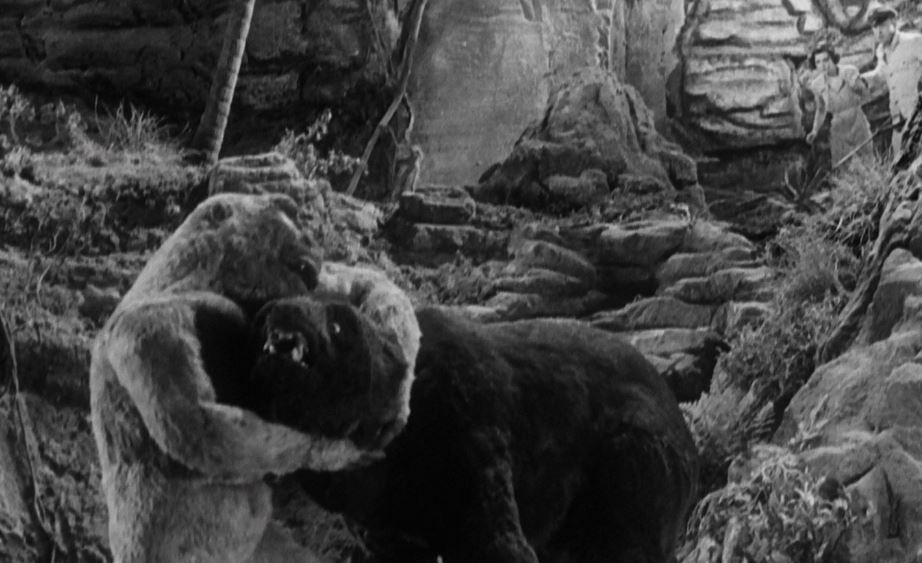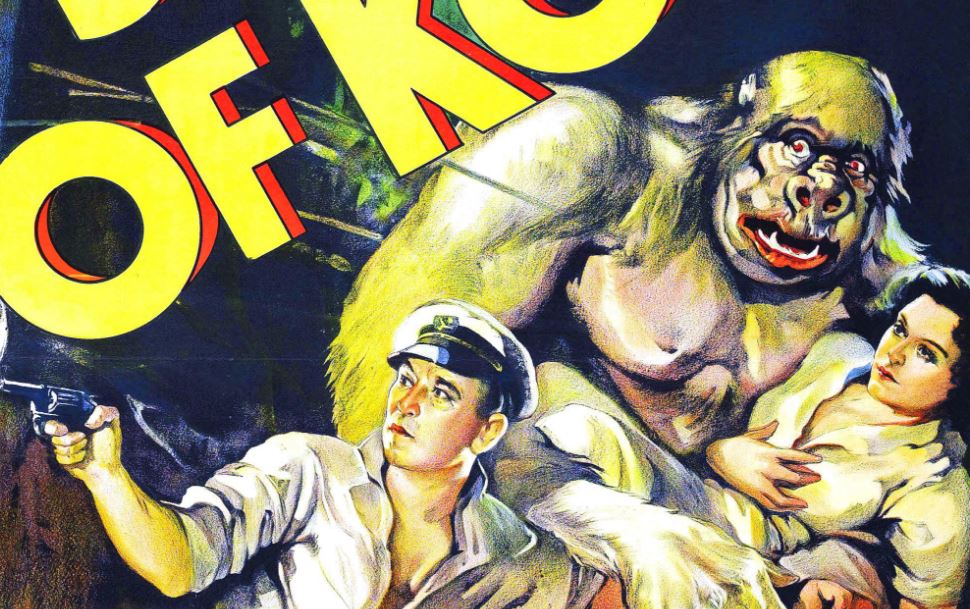Kong: Skull Island is out on March 10th, and it looks bleak as hell. And that’s by design. Director Jordan Vogt-Roberts, who’s tying the movie into a shared cinematic universe with the 2014 Godzilla movie, has said that the flick is influenced by Apocalypse Now. Rather strange inspiration for a movie that’s ultimately about fighting a giant ape. But I suppose corporate researchers crunched the numbers and concluded that people want their movies to be dark and sad and not much fun, so, unfortunately, Kong: Skull Island fits perfectly into the current gritty-reboot zeitgeist. On the plus side, it looks as though John C. Reilly will be providing some much needed comic relief, and who doesn’t love some John C. Reilly? People without hearts, that’s who.
Anyway, I don’t know, I guess the original King Kong probably seemed pretty bleak for its time. It was a fairly self-serious epic that had a running time of almost two hours; a very long film in an era when genre movies were generally around an hour long. And it still holds up. Well, if you can get past the racism. I mean, about 75% of the movie consists of King Kong smashing stuff and killing things, both on his island and in the streets of Manhattan, so you can skip to those parts, if you want.
Besides the racism, there’s some other stuff going on, symbolically, with the movie. It’s a kind of spectacle disaster movie about spectacle disaster movies. I mean, it’s essentially about a greedy director’s quest to find the ultimate movie spectacle. He leads an expedition to a previously unknown island that’s filled with dinosaurs and giant apes and the ape ends up on Broadway. (If you can make it here, you can make it anywhere!)

And the film’s effects have become legend at this point. Willis O’Brien was a pioneering stop-motion animator behind movies dating back to 1917. He worked for Thomas Edison, for God’s sake. Combining the animation with front projection created something that almost seamlessly blends real actors with models of dinosaurs, giant apes, and all manner of prehistoric creature. Even eighty-plus years later, the effects hold up pretty well. We know the tricks now, but in 1933, these effects left people scratching their heads trying to figure out how all of this was done.
O’Brien didn’t like the Son of Kong script, so he left the effects to his assistants. Not that there’s much animation to speak of, though. We only see Kong’s eponymous son in the third act, and he doesn’t do a lot.
Ruth Rose, who co-wrote the original screenplay, was commissioned to write a follow-up as soon as the success of the original Kong was apparent. Only 250,000 dollars were allocated to the sequel, and even in 1933 money, that wasn’t much for such a big production. Besides, the sequel was eventually released just nine months after the original, so Rose was under a lot of pressure to finish the thing quickly. She wrote a very scaled-down story that saved the animation until the last act. Since she couldn’t make a bigger spectacle, she decided to emphasize the comedy, but the movie really isn’t very funny. It is goofy, though, so take that how you will. When the younger, smaller, Kong gets into a fight with a bear, the thing comes off far more cartoonish than the original film, which was actually quite brutal at times. At one point, Kong kills a tyrannosaurus by pulling its jaws apart. You actually kind of cringe at that scene, but there’s nothing much to cringe about in The Son of Kong’s fight scenes. That’s okay, though. We’re watching a giant ape fighting a bear. If you can’t find the humor in that, you’re probably pretty dead inside.

The Son of Kong opens as director Carl Denham (Robert Armstrong) is holed up in his rented room in a boarding house, being hounded by the press and sued to shit by the city of New York for unleashing a giant ape on the city that caused an enormous amount of property damage. Denham is about to be indicted by a grand jury for his crimes when he gets an offer from the captain of the ship that originally brought Denham and his crew to Kong’s Island (and who’s also being sued): go rogue with him and make a living moving the ship from port to port hauling freight. Not sure why the good Captain Englehorn would want to pal around with the guy who bankrupted him and forced him to flee the country of his birth, but there you go. Maybe he just has a big heart.
At a port in the Indian ocean near Kong’s Island, Denham and Englehorn stop off in a weird little shack to take in a show. There’s dancing spider monkeys, normal size. Nice. Then Hilda (Helen Mack) sings a song terribly. Turns out Hilda is the daugher of a disgraced circus impresario who’s fallen on hard times and has been forced to take this tiny, pathetic version of his show on the road. A little later he’ll get burned to death for no real reason I could tell except that the plot demanded it. Sorry, guy, but sacrifices must be made. So Hilda stows away on Denham and the good captain’s ship. She and Denham fall in love, of course, since the plot demands a love interest, but it’s kind of creepy since she’s definitely in her 20’s and he’s got to be in his 40’s. By the time all this weird nonsense is over, we make it to the island where they find the eponymous son of King Kong.
Denham’s a creepy guy. I just have to put that out there. He’s into “saving” younger, beautiful women who need his help. In the first film he saved Fay Wray’s Ann Darrow from homelessness and jail when she tried to steal a piece of fruit from a vendor. And now this business with Hilda. Weird.
When the ships gets to the island, there’s a kinda-sorta political narrative going on as Denham, Captain Englehorn, Helen, and a down on his luck former ship’s captain who originally gave Denham the map to Kong’s Island, are forced off the ship and into a lifeboat. The underpaid and overworked crew have had enough and are going to steal the ship. Good for them. Except, no, they’re pretty much portrayed as goofy villains here. As Denham and company row away toward the island, one of the crew members even says, comically, “Go, you blasted bourgeois!” Yeah. But even though Denham is the hero here, he really is quite a dick, motivated only by greed. That was the entire reason he stole a giant ape from an island of prehistoric animals in the first movie instead of, I don’t know, letting the scientific community know or something. And even here in the sequel, as humbled as he’s become, he still takes a huge diamond from what is clearly someone or something’s sacred temple. “Blasted bourgeois,” indeed.
Did I mention it’s forty minutes into an hour-long movie until we finally see baby Kong? That’s a long time if you’re expecting the kind of wall-to-wall destruction from the first film. We do get a few stop-motion fights, but it’s not much. The giant ape is an innocent little fella who befriends the humans after they rescue him from some quicksand. There’s even quite a moving scene at the end, when the island is being destroyed by earthquake because the plot demands it, where little Kong saves Denham from drowning, which kills him in the process. Really, it’s not a bad little flick. Awkward romance, sure, and a plot that doesn’t make any sense if you think too much about it, but there’s a lot of humanity and pathos in the thing. Will Kong: Skull Island have any sort of humanity to it, or will it simply be a dark, depressing affair? We’ll have to wait and see, but the trailer certainly doesn’t look too promising.
Some of the coverage you find on Cultured Vultures contains affiliate links, which provide us with small commissions based on purchases made from visiting our site.

